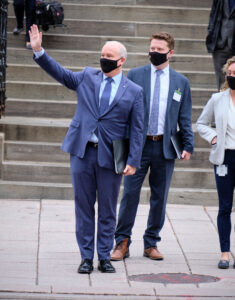Conservative Party Convention – What is at Stake?
 Canada’s three major political parties are about to hold conventions. The Liberals, Conservatives, and New Democrats postponed conventions from 2020 due to the COVID-19 pandemic.
Canada’s three major political parties are about to hold conventions. The Liberals, Conservatives, and New Democrats postponed conventions from 2020 due to the COVID-19 pandemic.
In “normal” times, party conventions are an opportunity for party members from across the country to meet in person, debate policies, network, engage with Members of Parliament and re-energize their grassroots base either between or just before elections. However, with conventions now moving to a virtual setting, the flavour and tenor of them will be quite different this time.
Conventions within the Context of the Parliamentary Schedule and Budget Timing
Canada’s Conservatives are holding their convention first and runs until Saturday. The Liberals and New Democrats will follow with their own virtual conventions the weekend of April 9-11. All three conventions will occur right before the next session of the House of Commons, which sits April 12 to May 14. It is widely expected that the long-awaited federal budget (there has not been a budget since 2019) will be delivered by Finance Minister Chrystia Freeland within the April 12-May 14th timeframe.
Since the NDP has stated that it will support the government on the budget, it is likely that the only path to an election this spring is if the Prime Minister asks the Governor General to “dissolve” Parliament and calls an election. Whether this happens depends on two key factors: how many people have been vaccinated and if the Liberals believe they can convince Canadians that they need a majority mandate to deliver their post-pandemic vision for the country.
A Note on Polling
With the possibility of an election before the summer, it is worth looking at recent polling. The Conservatives have the support of 29-31% of Canadians. Being in second place increases the angst amongst core party supporters. Previous Conservative Party leader, Andrew Scheer, won Canada’s popular vote in 2019 with 34% of support but this only translated into 121 of 338 seats. The Conservative base of support is between 25 and 30% of Canadians but, to form a government, they need to be in the 36-39% range to win enough seats. This means broadening support from Canadians who are not partisan voters and are open to switching from other parties.
The Conservative Convention
As a rule, the grassroots of the Conservative Party and those who are selected to be party delegates to a convention relish the opportunity to debate policy both on the plenary floor and in the corridors and late-night hospitality suites. Even though the convention is virtual, there will be many delegates ready to debate the proposed policy and constitutional submissions and amendments.
O’Toole Must Define His Vision for Canada
Given the potential for an election, there is a lot at stake for the Conservative Party and its leader, Erin O’Toole, at this convention and in its immediate aftermath. It is an opportunity for O’Toole to establish his leadership and vision for the country. However, this will be a tough balancing act for him because he needs to provide enough policy substance to keep the party’s base with him while moving the party more towards the centre of the political spectrum where accessible Conservative voters live. Since he was elected leader, he has made clear moves to demonstrate that he intends to move the party more to the centre – on social issues, climate change, foreign aid, and in other areas. But he needs to stretch to reach new voters while not disillusioning the Conservative base.
O’Toole’s keynote speech on Friday night is his chance to put his vision for the country into one coherent message that the party, and potential Conservative voters, can rally behind.
Inter-party Healing
In the leadup to almost every Conservative convention, there are stories in the media about divisions within the party and how one group of Conservatives is trying to “take over the party.” This is the reality of conservativism across Canada.
This year has been no different, with the O’Toole and the convention team dealing with social conservatives trying to pursue a debate on their issues, which ultimately proved unsuccessful in making it to the convention process. In addition, the Conservative caucus, which is largely to the right of the average Canadian voter, wants a clear policy position that demonstrates the Conservatives are an alternative government-in-waiting.
All of this is not an easy task for a new leader. Since the amalgamation of the Reform and Progressive Conservative Parties, the “blue tent” is an amalgamation of western populists, libertarians, social conservatives, Quebecois nationalists, and progressive Conservatives from Ontario and Atlantic Canada. It is always a challenge to find the right balance to keep this coalition together. When the Conservatives are in opposition, it is an even greater challenge as many of these factions will advocate that their policies are the only way to form government.
Conservatives: What They Need to Achieve
If the party, and its leadership under O’Toole, can demonstrate unity at the end of the convention (as they have at every previous convention), then the convention will have been a positive exercise in having the debate but unifying behind the common cause of forming the next government.
The challenges ahead for Erin O’Toole and his leadership team are not easy — unite the factions who give the party the financial and volunteer support in-between and during elections, energize the Caucus as a force to challenge the Liberals, and emerge stronger from the weekend than they entered it.